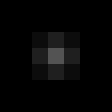 Originally posted by brntoki
Originally posted by brntoki 
How does the deblur function actually work?
Deblurring on the basis of deconvolution attempts to undo the effect of a known blur, e.g., that of a lens defocus. Let's stick to this latter example as it is more straightforward to discuss than the AA-Bayer-Filter case.
Imagine the recorded blurred image to be a combination of a clean signal (the image data as it would be recorded if every sensel could record all colours and no blurring would be needed) and some blur (e.g., caused by lens defocus). Mathematically, this combination is called a convolution. The point spread function of the blur is multiplied with every single "clean image" data point and the sum of all these blurred points is the resulting blurred image. You can reverse such a convolution with a
deconvolution.
BTW, the same principle can be used to undo the effect of motion blur.
As such, deconvolution is fundamentally different (and computationally more intensive) than standard micro-contrast enhancement.
P.S.: Kudos to your attitude, i.e., being open to learning new things!


 Similar Threads
Similar Threads 





 ), and played around with it (via LR4.2) on some RAW Pentax K-5/Q files. Perhaps my skill level has changed so I can better appreciate what it does, or they have vastly improved the program. Anyway, it offers a very powerful alternative to traditional sharpening and I plan to use it more. Again, thanks for the tip.
), and played around with it (via LR4.2) on some RAW Pentax K-5/Q files. Perhaps my skill level has changed so I can better appreciate what it does, or they have vastly improved the program. Anyway, it offers a very powerful alternative to traditional sharpening and I plan to use it more. Again, thanks for the tip. 








 Post #52 by regor
Post #52 by regor








